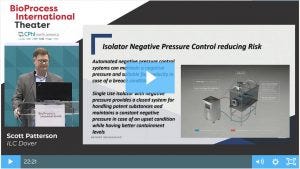- Sponsored Content
Single-Use Technology for Containment During ADC HandlingSingle-Use Technology for Containment During ADC Handling
July 11, 2019
Sponsored by ILC Dover
 Scott Patterson, vice president of commercial sales, ILC Dover
Scott Patterson, vice president of commercial sales, ILC Dover
Antibody–drug conjugates (ADCs) are increasing in popularity, with a robust pipeline that could lead to a US$10-billion market over the next several years. These novel treatments combine the high potency of small molecules with the targeting ability of monoclonal antibodies (MAbs). However, the challenge of such treatments is that they combine a highly potent, toxic material with a large protein that will target a treatment area. As a result, manufacturing the small molecule requires extreme controls specific to facility design, high-containment isolators, personal protective equipment (PPE), and operator training.
Patterson recommends using single-use containment systems for ADC handling. Such systems can provide the needed controls while reducing the cost of manufacturing to enable operation of multiuse facilities. Single-use flexible isolators have been proven by risk assessment studies to meet the high-containment performance needed for handling ADCs (<30.0 ng/m3). Isolators can be used both for handling solids in chemical synthesis of toxic materials and in downstream processing, when handling liquids to protect from spills and aerosolization.
One of the key issues in working with any toxic compound is containment at the source. That is common in processes for which open handling is still performed, and it is intended to address a major risk: Powders can become airborne and travel through a processing suite or even an entire facility, making additional cleaning necessary and potentially endangering operators.
The ADC “payload” is a highly potent active pharmaceutical ingredient (HPAPI) in solid or powder form, so the risk of operator exposure is significant. An additional risk is that multiple facilities are involved in the process. Some of those are multiuse facilities where many different compounds may be produced. One factory may make the payload and linker while another facility makes the MAb, still another performs conjugation, and so forth. The downstream processes are less risky than the upstream steps, but isolation and containment remain essential to protect against aerosolization. One way to protect operators is through negative or positive pressure controls to create aseptic conditions.
Single-use systems minimize cleaning processes, reducing costs and risks of cross-contamination. Cleaning protocols, hold times, and validation add costs and yet leave risk for product retention and cross contamination. Single-use products with wet-in-place and/or deactivation processes can be removed safely for disposal/incineration, and that also dramatically reduces labor and costs associated with cleaning.
Capital expenditure for isolation or containment is much lower when using a single-use device. Conventional stainless steel technologies cost hundreds of thousands of dollars to implement, whereas the costs associated with single-use systems are dramatically lower, with less ongoing cost of ownership. By eliminating cleaning and validation, companies can reduce costs significantly.
Additionally, single-use technologies provide process flexibility to adapt systems easily for changes in a process and continuous improvement. In the biologics industry, flexible factories are highly desirable. By using disposable systems such as flexible isolators, companies can repurpose the equipment, redesign the equipment, and make changes more easily than ever before. Continuous improvement becomes economically feasible and can improve ergonomics and containment.
You May Also Like






